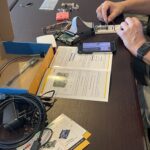Unleashing Creativity: Exploring Arduino Uno and the Car Project with Young Innovators

The workshop on Arduino Uno had already left a lasting impact on both the children and myself. As we transitioned to the Car Project, I was eager to witness how the newfound knowledge from the Blink Project would shape the children’s understanding and enthusiasm for this more complex challenge. The excitement in the room was visible as the children gathered around their workstations, eager to embark on the next adventure. The Car Project required them to build a small robot car using Arduino Uno and various components like motors, sensors, and wheels. The task was more intricate than the Blink Project, but the children’s eagerness and confidence had grown significantly since the beginning of the workshop. The children’s previous experience with the Blink Project proved to be invaluable. They approached the Car Project with a newfound sense of enthusiasm, curiosity, and determination. It was evident that they saw the potential of applying their skills to create something more substantial and interactive.
The knowledge gained from the Blink Project laid a solid foundation for understanding the basics of Arduino programming and circuitry, which were essential for the Car Project’s success. Many of the children displayed an intuitive understanding of wiring and coding, making the initial setup and configuration more seamless. Throughout the Car Project, I noticed how the children embraced the repetitive process. They were not afraid to experiment, test, and revise their designs as they encountered challenges along the way. The willingness to adapt and learn from their mistakes showcased a newfound level of confidence and resilience, which I believe was fostered by the Blink Project’s debugging exercises.
One of the most remarkable transformations I witnessed was the emergence of natural leaders and collaborators among the children. Those who had excelled in the Blink Project took on mentorship roles, guiding their peers through the complexities of the Car Project. This collaboration created a positive learning environment, where knowledge was freely shared, and everyone felt supported in their exploration. Moreover, the Car Project fostered an appreciation for STEM disciplines among the children.
They began to see how science, technology, engineering, and mathematics intertwined in the real world, motivating them to pursue further studies and careers in these fields. As the workshop drew to a close, I was filled with a sense of fulfillment. The journey from the Blink Project to the Car Project showcased how these children had evolved into confident and creative young innovators. They had harnessed the power of Arduino Uno, gained a deep understanding of electronics and coding, and most importantly, developed a passion for learning and problem-solving.













